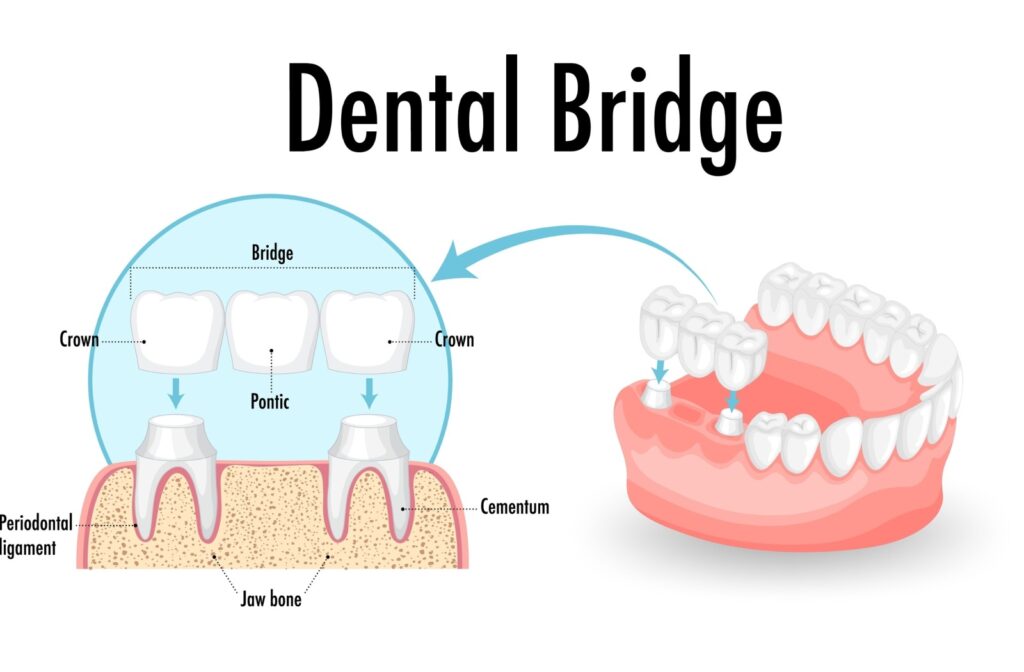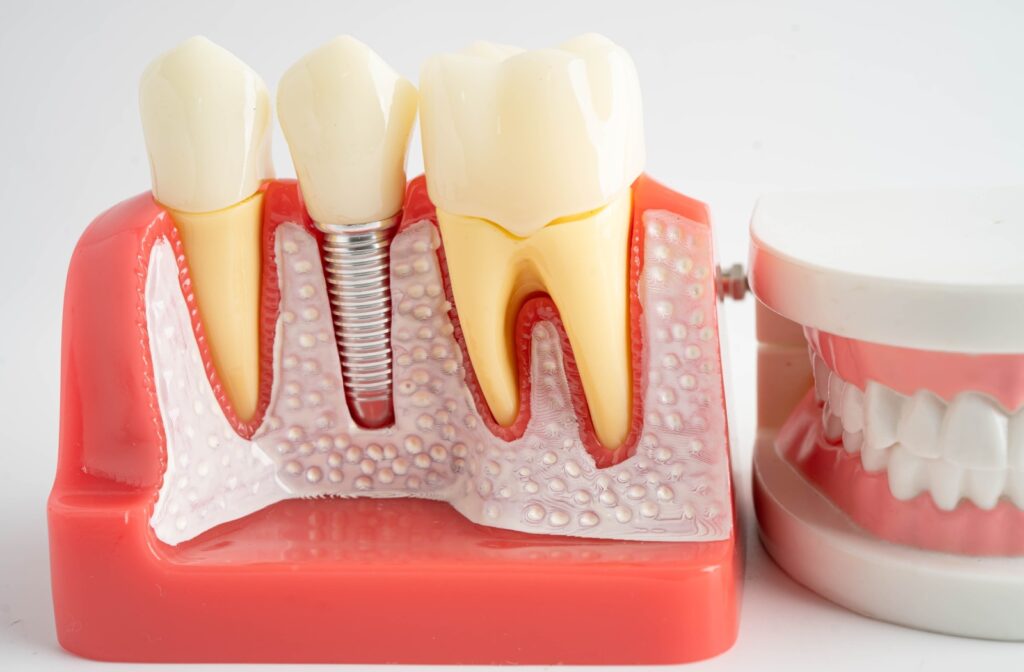When you lose a tooth, the gap it leaves behind affects more than just your smile. Missing teeth can impact your family’s ability to eat comfortably, speak clearly, and feel confident in social situations. At Montgomery Dental Centre, we help families understand their options for restorative dentistry to restore both function and confidence.
Both dental bridges and implants can effectively replace missing teeth, but the right choice depends on your family’s specific needs, health conditions, and budget. Each option offers unique benefits that can help restore your oral health and improve your quality of life.
Why Replace Missing Teeth Matters for Your Family’s Health
How Missing Teeth Affect Your Daily Life
Missing teeth create immediate challenges for you and your family members. Chewing becomes difficult, especially with harder foods like apples or nuts. Speech can change, particularly when front teeth are missing, affecting how clearly you communicate with others.
Your remaining teeth start to shift into the empty space over time. This movement changes your bite and can make it harder to clean your teeth properly, leading to food getting trapped in new gaps.
Long-Term Oral Health Consequences
The jawbone beneath a missing tooth begins to shrink when it no longer receives stimulation from tooth roots. This bone loss can change your facial structure and make your cheeks appear sunken. The process continues gradually, affecting the stability of nearby teeth.
Adjacent teeth become more vulnerable to decay and gum disease as they shift position. The altered bite pattern puts extra stress on some teeth while others don’t get enough use, creating an imbalance in your mouth.
Impact on Children & Adult Family Members
Children who lose permanent teeth early may develop speech patterns that become difficult to correct later. Their remaining teeth can shift more dramatically than adults’, potentially requiring orthodontic treatment to realign their bite.
Adult family members might avoid certain foods or social situations due to self-consciousness about their appearance. This can affect family meal choices and social activities, impacting everyone’s enjoyment and nutrition.
What Are Dental Bridges & How Do They Work?
The Basic Bridge Design
A dental bridge consists of one or more replacement teeth (called pontics) anchored between two crowns. These crowns fit over the natural teeth on either side of the gap, creating a “bridge” across the missing tooth space.
The bridge functions as a single unit that you can’t remove. It looks and feels similar to your natural teeth once your mouth adjusts to the new restoration.
Types of Materials Used
Porcelain bridges match your natural tooth colour and provide a realistic appearance. Metal frameworks underneath the porcelain add strength and durability for everyday chewing forces.
All-ceramic bridges contain no metal and work particularly well for front teeth where appearance matters most. Your Calgary dentist can help you choose the material that works for your specific situation and budget.
How Bridges Attach to Your Teeth
Your dentist shapes the supporting teeth (called abutment teeth) to accommodate the crowns that hold the bridge. These teeth receive a thin layer of removal to create space for the crown material.
The bridge attaches permanently using dental cement. You care for it like your natural teeth, though you’ll need special floss threaders or water flossers to clean underneath the replacement tooth.
Understanding Dental Implants
The Titanium Post Process
A dental implant starts with a small titanium post surgically placed into your jawbone where the tooth root used to be. This post acts as an artificial tooth root that can support a crown, bridge, or denture.
The surgery typically takes place in your dentist’s office using local anesthesia. Most people can return to work and normal activities within a few days, though complete healing takes several months.
How Implants Bond with Your Jawbone
Titanium naturally bonds with bone tissue through a process called osseointegration. Your jawbone grows around the implant post over 3-6 months, creating a stable foundation for the replacement tooth.
This bonding process helps preserve your jawbone density and prevents the bone loss that occurs with missing teeth. The implant stimulates the bone just like a natural tooth root would.
Crown Placement & Final Steps
Once the implant integrates with your jawbone, your dentist attaches an abutment piece to the post. This connector holds the final crown, which matches your other teeth in size, shape, and colour.
The crown screws or cements onto the abutment, completing your new tooth. You can brush and floss around it just like your natural teeth, with no special cleaning requirements.
Bridge vs Implant: Key Differences You Should Know
How Long Each Option Lasts
Dental implants can last 20+ years or a lifetime with proper care, while bridges typically last 5 to 15 years before needing replacement. The longevity difference comes from how each option interacts with your mouth and jawbone.
Bridges experience more wear because they rely on adjacent teeth for support. These supporting teeth can develop problems over time that require bridge replacement even if the bridge itself remains intact.
Bone Health & Jawbone Strength
Implants help maintain your jawbone by providing the stimulation that prevents bone loss. The titanium post transfers chewing forces directly to the bone, keeping it active and healthy.
Bridges don’t prevent bone loss in the area of the missing tooth because they don’t extend into the jawbone. The bone continues to shrink gradually, though this doesn’t typically affect the bridge’s function.
Procedure Complexity & Time Required
Bridge treatment usually takes 2-3 weeks from start to finish. Your dentist prepares the supporting teeth, takes impressions, places a temporary bridge, then fits the permanent bridge at a follow-up visit.
Implant treatment takes 3-6 months due to the healing time required for osseointegration. Some cases can be completed faster, while complex situations might take longer depending on your specific needs.
Effects on Your Other Teeth
Bridges require modification of healthy adjacent teeth to accommodate the supporting crowns. These teeth lose some natural structure permanently, which can make them more vulnerable to future problems.
Implants don’t affect your other teeth at all. Your adjacent teeth remain untouched and maintain their full natural structure and strength.
Function & Appearance Comparison
Both options restore your ability to chew and speak normally. Implants typically provide slightly stronger bite force since they’re anchored directly in the jawbone rather than supported by other teeth.
The appearance of both bridges and implants can match your natural teeth closely. Your Calgary dentist can create either option to blend seamlessly with your existing smile.
Cost Considerations for Your Budget
Bridges typically cost less initially than implants. However, bridges may require replacement multiple times over your lifetime, potentially making implants more economical in the long run.
Insurance coverage varies for both options. Many plans cover a portion of bridge treatment, while implant coverage has increased in recent years but remains less predictable.

Which Option Fits Your Needs?
Factors Your Calgary Dentist Will Consider
- Current bone density levels
- Overall health conditions
- Age & lifestyle factors
- Budget & insurance coverage
- Number of missing teeth
When Bridges Make Sense
Bridges work well when the teeth adjacent to the gap already need crowns or large fillings. This situation allows you to address multiple dental needs with one treatment plan.
If you prefer to avoid surgery or have medical conditions that complicate implant placement, bridges offer a non-surgical solution. They also work well when you want to complete treatment quickly.
When Implants Are the Right Choice
Implants make sense when you want to preserve your healthy adjacent teeth. They’re particularly valuable for younger patients who can benefit from their longevity and bone preservation qualities.
If you have multiple missing teeth that aren’t adjacent to each other, individual implants can replace each tooth without connecting them like a bridge would require. This approach maintains more natural function and easier cleaning.
Your Next Steps with a Calgary Dentist
What to Expect During Your Consultation
Your dentist will examine your mouth, take X-rays, and discuss your medical history to determine which options suit your situation. This evaluation includes checking your bone density, gum health, and the condition of adjacent teeth.
You’ll receive a detailed treatment plan explaining the recommended approach, timeline, and costs involved. Your dentist can show you examples and answer questions about what to expect during and after treatment.
Questions to Ask Your Dental Team
Ask about the expected lifespan of your recommended treatment and what maintenance it requires. Discuss how the procedure will affect your daily routine and what temporary limitations you might face.
Find out about payment options, insurance coverage, and any alternatives that might work for your situation. Your dental team can help you understand the long-term investment each option represents.
Schedule Your Dental Assessment
Don’t let missing teeth continue to impact your family’s health and happiness. Early treatment often provides more options and can prevent complications that develop when gaps remain unfilled.
Contact Montgomery Dental Centre today to schedule a consultation where we can evaluate your specific needs and help you choose the tooth replacement option that works for your family’s health and budget. Our team will guide you through each step of the process with the care and attention your family deserves.




